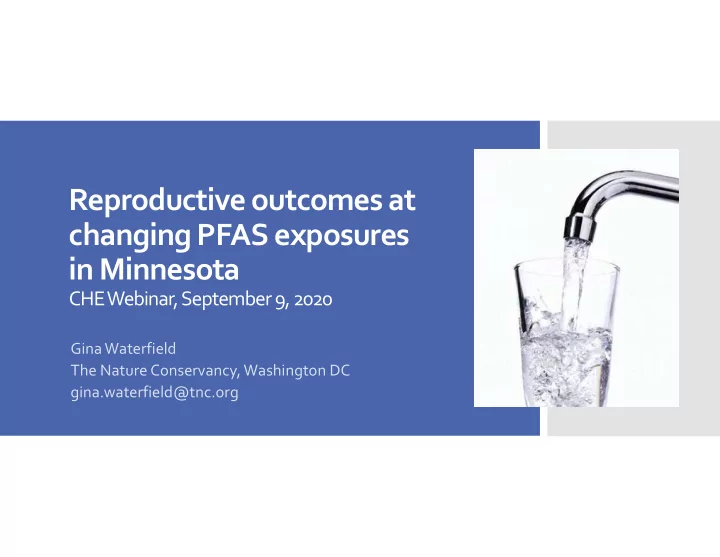

Reproductive outcomes at changing PFAS exposures in Minnesota CHE Webinar, September 9, 2020 Gina Waterfield The Nature Conservancy, Washington DC gina.waterfield@tnc.org
� Production and disposal of PFAS at multiple locations in Minneapolis East Metro Area beginning in 1950s � High levels of PFOA (0.07 to 0.70 μg/L) and PFOS (ND to 1.04 μg/L) detected in Oakdale municipal wells in 2005 Background � Almost all 27,000 Oakdale residents served by municipal water � Granular activated charcoal (GAC) filtration installed for municipal supply in 2006 � PFAS detected in other surrounding communities but less consistent exposure, no large-scale intervention
� All singleton birth records in all zip codes in Washington County 2002 to 2011 (MDH) � Birth weight � Gestational age � Sex � Individual-level maternal characteristics (MDH) � Age Data Sources � Residence zip code � Marital status � Educational attainment � [Drug use and Medical risk factors] � Zip code-level characteristics (ACS) � Income � Racial/ethnic composition
Other Other Control Zip Control Zip Oakdale Oakdale Affected Affected Codes Codes Variable 2002-2006 2007-2011 2002-2006 2007-2011 2002-2006 2007-2011 Number of Births 1,685 1,715 9,017 8,600 13,811 14,237 Maternal Characteristics Age Mean (SD) 28.5 (5.7) 28.1 (5.5) 30.0 (5.5) 29.8 (5.4) 28.6 (5.8) 28.5 (5.7) Marital Status % Married 70.5% 63.2% 82.7% 78.6% 70.9% 65.6% Educational Attainment % No HS Diploma 5.7% 6.2% 3.7% 3.4% 7.3% 7.8% % College Degree 38.7% 35.9% 53.6% 56.0% 38.9% 40.6% Summary of Newborn Characteristics Sex Selected % Female 47.4% 50.3% 48.5% 48.2% 48.8% 49.3% Birth Weight (grams) Mean (SD) 3,390 (573) 3,360 (542) 3,445 (545) 3,409 (538) 3,419 (551) 3,392 (538) Characteristics % < 2,500g 5.7% 4.7% 3.8% 4.2% 4.3% 4.4% % < 1,500g 1.0% 0.7% 0.7% 0.7% 0.8% 0.7% Gestational Age (weeks) Mean (SD) 38.8 (2.0) 39.0 (1.8) 38.9 (1.7) 38.9 (1.9) 38.9 (1.9) 38.9 (1.8) % < 37 Weeks 7.2% 5.9% 6.3% 6.4% 6.4% 6.3% % < 32 Weeks 1.1% 0.8% 0.7% 0.9% 0.8% 0.7% Zip Code Characteristics Household Income ($) Median 73,588 70,040 99,082 96,002 77,474 74,027
Identification Strategy • Compare outcomes in affected communities, and changes in outcomes in Oakdale, to control communities without known PFAS contamination of drinking water supplies • Implicitly controls for fixed differences in community characteristics • Implicitly controls for changes over time common Credit: Columbia Public Health, Columbia University, to all communities https://www.publichealth.columbia.edu/research/population-health-methods/difference-difference-estimation
Estimating Equations Individual level regressions with explicit controls for maternal characteristics and additional zip code level controls: � �������� � �������� � � �
Reducing PFAS exposure had a small impact on birth weight and gestational age
Reducing PFAS exposure substantially and significantly reduced the odds of adverse birth outcomes in Oakdale
Reducing PFAS exposure appears to have had a positive effect on the general fertility rate in Oakdale but the response is slower
Conclusions � Reduced exposure to PFAS in drinking water was associated with slightly higher birth weight and gestational age on average � PFAS filtration significantly reduced the odds of low birth weight and preterm birth in Oakdale relative to other communities � Response in general fertility rate was slower but appears to be positive � Caveats and limitations: � Exposures in Oakdale and other affected communities not known � Cannot disentangle effects of PFOA, PFOS and other PFAS � Cannot rule out confounding factors, despite “quasi-experimental” study design � Continued need for follow-up and monitoring of outcomes; additional studies of PFAS interventions
Recommend
More recommend